Emigration
from Oberfranken in the 19th Century
-
Emigrants from Dormitz
-
History of Dormitz
Emigration in the
19th century /4/
In the Middle Ages people were considered a kind of accessory to the land
they lived and worked on. As a result of that, they were not allowed to
leave their village or district. They completely depended on the arbitrariness
of the sovereign, whether an exception was made or not.
Since 1818 Bavarian citizens had the right to emigrate to other German states, if those states were willing to receive them. They did not have the right to emigrate to non-German states, but usually the permission was granted.
- no liability to
military service.
- all public duties (such as taxes) paid in full.
- all private debts settled.
- no pending cases
in court and no sentences to serve.
- enough money.
(The graph was slightly smoothed by a "moving average" in order to see the main
trends more clearly, see original curve)
Between 1836 and 1871,
the majority (83%) of Bavarian emigrants went to USA and 14% to other
German states. In the years 1872-1878 & 1887-1890, 27% went to USA
and 69% to other German states and the Austrian-Hungarian Empire /4.82/.
So the left
half of the curve is dominated by emigration to North America (83%), the
right half is not (only 27%).
Some authors define five "waves" of emigration: 1847-48; 1851-53;
1872; 1880-83; 1890 /6.113,114/. Considering the diagram, this appears
rather arbitrary to me. If one wants to define waves, I would propose
two main waves, separated by the American Civil War (1861-1865). These
two main waves show several peaks. The first one, the "American wave",
clearly shows three maxima, which are correlated to three clear maxima
in the development of the price for rye.
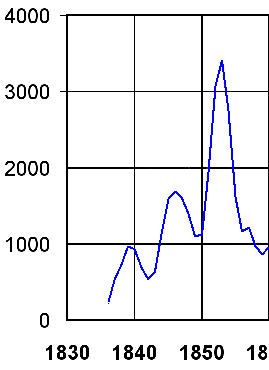

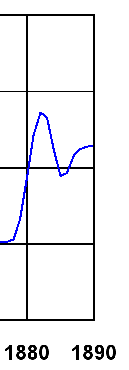
A few factors should
be mentioned, which seem to have influenced the trends (move mouse over
diagram):
- the price for rye (in arbitrary units) as an indication how hard it
was especially for poor people to make a living /4.90/.
- the civil war in USA
- new laws in 1868 in Bavaria made it easier to marry, and the freedom
of trade was granted /4.78/.
What did they know about America, and from where?
There were reports
about journeys to North America published in books, magazines and newspapers.
Some guidebooks for emigrants tried to give information on how to make
the emigration the most successful.
The author of one guidebook complains about reports that were written
or ordered by speculators who bought lots of land and tried to attract
settlers by describing their state or county as being the "heaven
on earth".
But the letters from earlier emigrants certainly had the biggest influence
/8.28,29/. Below you can see one example.
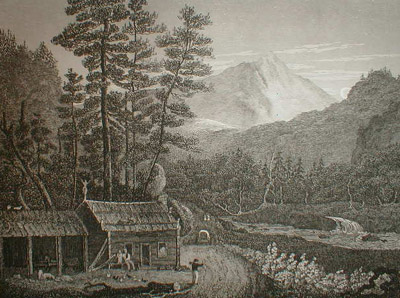
Steel engraving, Germany, about 1840, showing settlers and their block house in North America
This represents the "romantic view" ("Blockhaus-Romantik")
Summary of the letter:
- they know what is going on in Germany from letters and newspapers
- prices for different goods are compared
- what emigrants should bring with them from Germany (e.g. seals and whetstones)
- after half a year he owns nearly everything a farmer needs
- timber of very good quality is easily available
- all kinds of trees grow in abundance
- the days are longer and the climate is better than in Frankonia
- land was already bought for Jacob Regenfuss
- some hints regarding the journey and where to buy land and where not
to
"Bericht
über eine Reise nach den westlichen Staaten Nordamerika' s und einen
mehrjährigen Aufenthalt am Missouri"
Elberfeld: Samuel Lucas, 1829
Zweite Auflage: Bonn, 1834
The author Gottfried
Duden reports about his journeys to North America in the years 1824,1825,
1826,1827 and about his stay at the Missouri.
The first edition of this book was printed in 1500 copies.
The pre-requisites
for a successful migration according to Gottfried Duden are:
- sufficient
money
- good guidance/organization
- medical protection
- other German families nearby
(page 359)
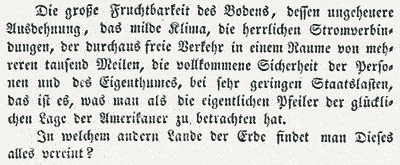
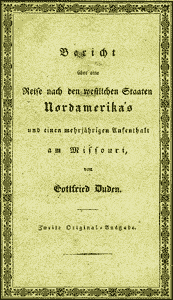
In which other country on earth does one find this all together?"
page 258
"Report on a Journey to the Western States of North America and a Stay of Several Years along the Missouri"; Ed.: James W. Goodrich; Columbia/ Missouri; Universtity of Missouri Press, 1980
|
Inhalt: |
Content: I. Countries for emigrationA General considerations B America, country, people, institutions and the situation in general C Individual American countries D Non-American points II. The Emigration III. The Embarkation IV. The Emigrant Ship V. The Arrival and Disembarkment VI. The Settlement and Life in the Countryside |
A Catechism for Emigration A edited |
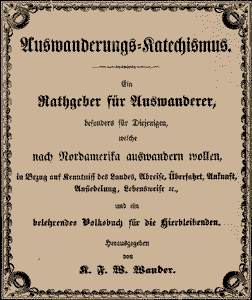 |
||||
| In 660 questions and answers in 6 chapters many important informations are compiled for migrants: e.g. | |||||||
|
4) Wohin richtet
sich der Hauptstrom der Auswanderer? |
4) Where do
most emigrants go to? |
New
German edition with comments and a very valuable bibliography:
ISBN 3-261-03799-7; "Wander, Karl Friedrich Wilhelm"; Herausgeber Wolfgang Mieder; Bern; 1988 |
|||||
Reasons for emigration
The population in Oberfranken increased steadily /4.85/ (see graph)
Until 1868 artisans suffered severely from the regulations of the ancient
craft guilds; flexibility and creativity were suppressed.
Very many people didn't earn enough money to make their living.
Most goods were hardly affordable. For example firewood was so expensive
that the district court Lichtenfels asked the government to lower the
price because the discontent of the people was increasing /8.17/.
Many properties were mortgaged. When the harvest was good, the farmers
could pay the mortgage interests. But when the harvest was bad or the
handcrafters had not enough jobs, the mortgages caused big problems /8.20/.
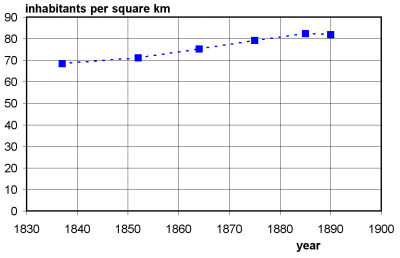
The law of succession in Franconia said that the properties had to be
divided among the heirs. As a consequence the land was fragmented, many
farms were too small to maintain a family. /8.21/
In 1834 new laws made it more difficult to become resident and to marry.
In order to become resident in a community, the person had to own a property
with a minimum tax yield of 1 fl and 30 Kreuzer and he had to prove that
he is able to earn his living. These two requirements made it virtually
impossible for e.g. servants, day-laborer and craftsmen to marry and have
a family. It' s not surprising that the statistics of those days show
many illegitimate children./8.22/
No indications for politically motivated emigration can be found in Oberfranken.
In 1848 there were some riots in some parts of Oberfranken, but the reason
was discontent with the miserable economic situation rather than discontent
with the political situation./8.27/
see also:
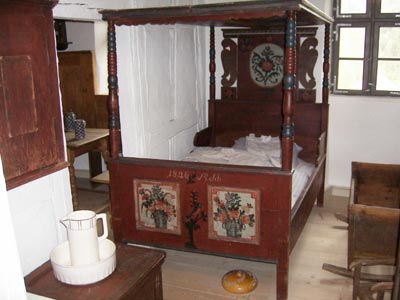
References
/4/ Auswanderungswesen in Bayern, G. Krieg, Sonderabdruck des Vereins für Socialpolitik, 52. Band, Leipzig 1898
/5/ Staatsarchiv Bamberg, Auswandererkartei
/6/ Wanderungsbewegungen in und aus Franken im 19. Jahrhundert. Klaus Guth. Jahrbuch für fränkische Landesforschung 49 (1989)
/7/ Fremdheitserwartung und Fremdheitserfahrung bei den deutschen Amerikaauswanderern im 19. Jahrhundert. Peter Assion. in Kulturkontakt, Kulturkonflikt/ herausgegeben von Ina-Maria Grevius. Frankfurt/ Main (1988)
/8/ Hintergründe der Auswanderung aus Oberfranken nach Nordamerika. Hans Schaub. Heimatbeilage zum Amtlichen Schulanzeiger des Regierungsbezirks Oberfranken. Bayreuth, Januar 1994, Nr. 206.